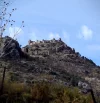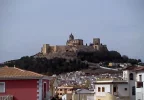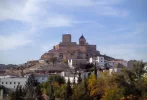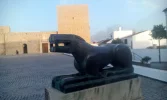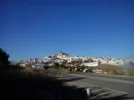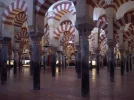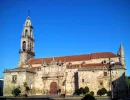- Time of past OR future Camino
- Except the Francés
The next section of my annual autumn adventure is to follow the camino Mozárabe from Granada to Guadalupe.
Granada to Pinos Puente:
Granada has some of the worst ugly sprawling suburbs of any great city. 20km gets you to Pinos Puente, and you are effectively still in a dormitory of Granada. Boabdil sighed when he got to the city limits. I did too but, unlike el rey Chico, mine was a sigh of relief rather than regret. At Pinos Puente there is a historic bridge, complete with guard tower, which two brave Moorish captain brothers tried to defend against the Christian hoards. Unlike Horatius and Herminius at the gate, they and their troops got slaughtered. The local albergue appears to be shut, so I stayed at the Hostal Montserrat, by the entrance to town. It was fine, 25€.
Pinos Puente to Moclin:
The day started badly, with the first rain of this camino. A tough track across muddy and claggy fields in pouring rain with thunderclaps for company, and I succeeded in slipping over and covering myself and my rucksack in mud. The sun came out by noon, when I had a tapa in Olivares, and met my first fellow peregrinos of the trip, a Dutch couple who are doing Granada to Córdoba. The next hour is quite strenuous, as you rise 400m in 4km before reaching Moclín, which has an amazing hilltop castle, described as the shield of Granada. It looks quite impregnable, but apparently a fireball from one of the Reyes Católicos' cannons got lucky, hitting the moorish gunpowder magazine and bringing down a bit of wall as a result, and tightening the noose round Granada.
I stayed in the Hostal, which is amazingly comfortable and right on the track. Off season, it often shuts except at weekends so I was lucky my new Dutch friends had booked, otherwise it might have been awkward. 25€ b&b, and they let us use their kitchen to knock up an evening meal as everything else in the village, except the tienda, was closed.
Granada to Pinos Puente:
Granada has some of the worst ugly sprawling suburbs of any great city. 20km gets you to Pinos Puente, and you are effectively still in a dormitory of Granada. Boabdil sighed when he got to the city limits. I did too but, unlike el rey Chico, mine was a sigh of relief rather than regret. At Pinos Puente there is a historic bridge, complete with guard tower, which two brave Moorish captain brothers tried to defend against the Christian hoards. Unlike Horatius and Herminius at the gate, they and their troops got slaughtered. The local albergue appears to be shut, so I stayed at the Hostal Montserrat, by the entrance to town. It was fine, 25€.
Pinos Puente to Moclin:
The day started badly, with the first rain of this camino. A tough track across muddy and claggy fields in pouring rain with thunderclaps for company, and I succeeded in slipping over and covering myself and my rucksack in mud. The sun came out by noon, when I had a tapa in Olivares, and met my first fellow peregrinos of the trip, a Dutch couple who are doing Granada to Córdoba. The next hour is quite strenuous, as you rise 400m in 4km before reaching Moclín, which has an amazing hilltop castle, described as the shield of Granada. It looks quite impregnable, but apparently a fireball from one of the Reyes Católicos' cannons got lucky, hitting the moorish gunpowder magazine and bringing down a bit of wall as a result, and tightening the noose round Granada.
I stayed in the Hostal, which is amazingly comfortable and right on the track. Off season, it often shuts except at weekends so I was lucky my new Dutch friends had booked, otherwise it might have been awkward. 25€ b&b, and they let us use their kitchen to knock up an evening meal as everything else in the village, except the tienda, was closed.



